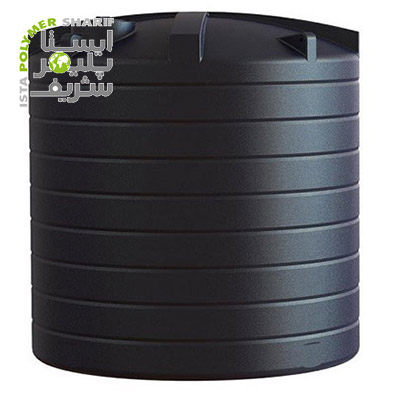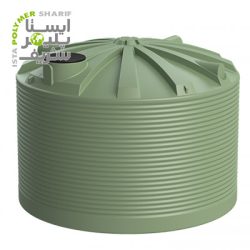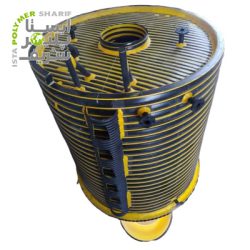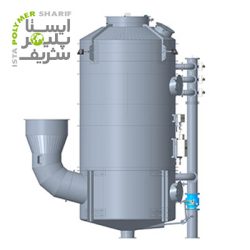An acid tank or anti-acid tank is a container designed for storing various types of acids. The tank must be carefully selected and made from high-quality materials depending on the type of acid it is intended to store. ABtank is one of the largest manufacturers of acid tanks, producing high-quality tanks for storing various acids and bases. Over the years, they have provided services to many cities including Tehran, Mashhad, Isfahan, Shiraz, Kish, and others. Depending on the type of acid, the anti-acid tank can be made from polyethylene or polypropylene.
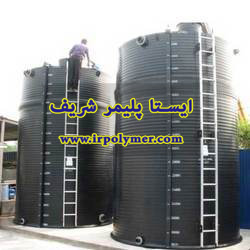
Types of Acid Tanks
As mentioned, an acid tank is necessary for storing or transporting acidic materials. Different materials are used to construct these tanks depending on the type of acid, including polyethylene, polypropylene, stainless steel, and composite materials. The tank material must be suitable for storing various acids like hydrochloric, phosphoric, nitric, or sulfuric acid.
These tanks come in various shapes such as conical, horizontal, cubic, and vertical, which do not affect their functionality but differ in shape and capacity. The design and construction of acid tanks must adhere to numerous standards and factors to ensure the stored solution, whether acidic or alkaline, maintains its properties.
Types of acid tanks produced by ABtank include:
- Sulfuric Acid Tank
- Hydrochloric Acid Tank – HCL
- Sodium Hydroxide Storage Tank – NaOH
- Composite Tank – FRP
- Polyethylene Tank
- Polypropylene Tank
- Stainless Steel Acid Storage Tank
Sulfuric Acid Tank
Certain corrosive substances and acids need to be stored for long periods in industrial applications. Due to the corrosive nature of acids like sulfuric acid, tanks must be made from materials that do not corrode and are resistant to chemical reactions.
Sulfuric acid storage tanks vary widely in design, material, and size. Materials used for liquid storage tanks include concrete, cement, metal, and plastic, designed to fit the required size.
Concrete and cement tanks, among the first storage tanks, have fallen out of favor for several reasons, and metal and plastic tanks are now more commonly used. Metal tanks are not resistant to chemical reactions and corrosion, leading to rust. Therefore, alternative measures are necessary for storing acids.
Polymer tanks made from polyethylene tank and polypropylene tank are suitable for this purpose because they are resistant to chemicals, acids, and bases. The long-chain structure of polymers provides suitable resistance, and polyethylene, a type of plastic, does not contain reactive agents.
Additionally, the affordability and lightweight nature of polyethylene tanks make them popular for storage. The storage capacity of acid tanks can be designed based on need, ranging from 2 cubic meters to several hundred cubic meters. Polyethylene tanks are available in single-layer to multi-layer varieties.
Nitric Acid Tank
Nitric acid (HNO3), also known as aqua fortis, is a colorless to yellowish acid with an unpleasant odor. It dissolves in water and turns brown when exposed to sunlight.
When storing acid, the corrosiveness, pH, and concentration must be considered. As previously explained, plastic tanks, which do not react with acid, are the best option. Nitric acid is used in aerospace, fertilizers, pharmaceuticals, and metal purification, making its proper storage crucial in various industries.
Hydrochloric Acid Tank
Hydrochloric acid tanks can be made from polyethylene. Given the corrosive nature of this acid, the tank must have a highly resistant body. The acid also emits vapors, so the tank must include an outlet for these gases to prevent accumulation.
Caustic Soda Tank
Caustic soda, or sodium hydroxide (NaOH), is a white, highly alkaline substance. It is corrosive and absorbs moisture from the air. Proper storage and transportation are essential. Caustic soda is used in various industries, including battery manufacturing, pharmaceuticals, oil and gas, petrochemicals, textiles, and dyeing.
Given the vulnerability of caustic soda to metals like aluminum and iron, metal tanks cannot be used for its storage. Stainless steel tanks have a corrosion resistance of 0.1 mm per year under 80°C with any caustic soda concentration. However, temperatures above 90°C can damage the tank.
High temperatures increase corrosion and cracking, rendering the tank unusable and causing environmental issues. Thus, plastic tanks, particularly polyethylene tanks, are recommended. They are chemically stable and provide good resistance, physical and mechanical properties, light weight, and cost-effectiveness.
Composite Acid Tank
Composite tanks are widely used in industrial and domestic applications due to their chemical resistance. These tanks can be classified into three categories based on their materials: GRP, SMC, and FRP, with FRP composite tanks used for storing chemicals and corrosive acidic fluids.
Stainless Steel Acid Tank
These tanks are made from an alloy of chromium, iron, and nickel, known as stainless steel. Key factors in producing a stainless steel acid tank include:
-
- External appearance
- Concentration of substances
- Chemical properties of the acid
Stainless steel tanks offer high resistance, non-reactivity with substances, durability, and a leak-proof body.
Polyethylene Acid Tank
These tanks are suitable for storing acids at temperatures below 68°C. They can also store other chemicals provided the temperature does not exceed 80°C. Polyethylene tanks can store hydrochloric acid.
Polypropylene Acid Tank
These tanks are used for acidic fluids that are not suitable for polyethylene tanks at high temperatures. Polypropylene tanks are highly resistant and do not react with the acidic contents. They are suitable for storing concentrated sulfuric acid.
Multi-Layer Polyethylene Tanks for Double-Walled Acid Tanks
Double-layer and multi-layer polyethylene tanks are recommended for sunlight exposure to prevent UV rays and potential reactions. They are available in horizontal and vertical types, depending on the available space and height restrictions.
Acids can be stored in GRP tanks, double-walled polyethylene acid tanks, cross-linked polyethylene, heavy polyethylene, and FRP tanks. Using double-walled acid tanks ensures that if the inner polyethylene layer becomes brittle, the outer layer remains unaffected due to the space between them. Double-walled polyethylene tanks are preferred over GRP tanks.
An acid tank should be elevated above ground level for easier and safer acid injection and discharge. The tank size should be double the volume of the acid to be stored.
Acid Tank Design
These tanks can be designed by ABtank to suit the fluid and your location. The design of polyethylene acid tanks should be determined according to the acidity of the specific acid. The storage location of acid tanks is very important because in hot environments, the rate of corrosion increases, while in very cold environments, freezing can occur. Therefore, a moderate temperature environment is crucial for storing these types of tanks. Additionally, anti-radiation paint can be used to prevent increased corrosion rates in the tanks.
These tanks can be designed by ABtank to suit the fluid and your location. The design of polyethylene acid tanks should be determined according to the acidity of the specific acid. The storage location of acid tanks is very important because in hot environments, the rate of corrosion increases, while in very cold environments, freezing can occur. Therefore, a moderate temperature environment is crucial for storing these types of tanks. Additionally, anti-radiation paint can be used to prevent increased corrosion rates in the tanks.
All the mentioned points are essential for storing any type of acid. One of the most commonly used acids is sulfuric acid, which is a very strong acid. Therefore, its long-term storage is very important, and all precautions must be followed. One specific consideration for concentrated sulfuric acid tanks is the sufficient thickness of the tank due to the excessive pressures exerted on the body, which can cause the tank to break. Therefore, double-walled polyethylene tanks and polypropylene tanks, as previously explained, are recommended.
Storing Acid in Tanks
Key points to consider when storing acid in tanks include:
- Using external spiral sheets/heating devices for very cold environments to prevent freezing in the acid tank.
- Using double-walled and multi-layered acid tanks for increased safety.
- Balancing high thermal temperatures to prevent acid corrosion.
- Using pressurized tanks for high vapor pressures above atmospheric levels.
- Maintaining a maximum acid concentration of 30% for better safety, as higher concentrations are strong oxidizers and can catch fire when mixed with reducing agents.
- Ensuring a maximum temperature of 50 degrees Celsius.
- Installing acid tanks on flat concrete surfaces.
- Ensuring that the sealing materials used, such as gaskets for acid tanks, are made of EPDM rubber.
- Using polyethylene for other fittings to avoid any reaction with the acid.
- Using large-diameter pipes during acid transfer to reduce corrosion, as corrosion occurs due to high-speed acid transfer.
External Shapes of Acid-Resistant Tanks
- Horizontal tanks ranging from a few hundred liters to several hundred thousand liters.
- Vertical tanks ranging from a few hundred liters to several hundred thousand liters.
- Conical tanks ranging from a few hundred liters to tens of thousands of liters.
- Cubic tanks ranging from a few tens of liters to thousands of liters.
Before the advent of plastic, double-walled polyethylene tanks, stainless steel, and galvanized tanks were used for storing acids. However, their high cost makes them less desirable today, and lightweight, cost-effective plastic tanks with high resistance to various acids are more commonly used. These double-walled tanks have two walls with a few centimeters of gap. For nitric acid, specifically, double-walled polypropylene fume tanks are also used.
Types of Acid-Resistant Tanks
the anti – acid tanks have different types , following the examination of the features of each :
Polyethylene and Polypropylene Acid-Resistant Tanks
An acid-resistant tank must possess high resistance to acids and alkalis, and have anti-corrosive properties against them. The manufacture of acid-resistant tanks is one of the activities of ABtank Company, which can be customized according to the customer’s preferences. Since polyethylene is a highly resistant material, it can be used for constructing acid-resistant tanks, allowing for worry-free use of polyethylene acid tanks.
Polypropylene tanks are another type that can be used for producing acid-resistant tanks. Due to its high resistance and more affordable cost compared to polyethylene, polypropylene has gained attention.
In addition to polyethylene tanks, plastic tanks reinforced with fiber, known as FRP, are also suitable for storing acids and alkalis. Acidic materials emit heat during dilution and various processes, causing the tank to heat up. Therefore, when constructing an acid tank, it’s important to consider the tank’s ability to withstand temperatures.
Stainless Steel Acid-Resistant Tank
Besides polyethylene and composite tanks for storing acidic materials, stainless steel tanks are another option for storing acids and alkalis. ABtank Company manufactures metal acid-resistant tanks with high resistance and durability against corrosive substances. The advantage of metal tanks for storing and preserving acidic and alkaline materials is their longer lifespan and higher impact resistance, allowing them to function for a longer period.
It is not recommended to store highly concentrated acidic or alkaline materials in acid tanks for extended periods, as they can cause indentation, perforation, or tearing of the tank.
Tanks produced by ABtank Company can store acidic materials such as sulfuric acid, hydrochloric acid, nitric acid, and more. For custom-made acid-resistant tanks for specific acids, it is best to contact the company for expert advice and to make an informed choice.
Storing Alkalis in Tanks
Key points to consider for storing alkalis in tanks include:
- Storing liquid caustic soda at inappropriate temperatures can cause it to solidify into a crystalline form, so storage temperatures should be between 5 to 55 degrees Celsius.
- Due to the slippery nature of liquid caustic soda, it easily leaks through cracks, making seamless plastic tanks a better choice over metal tanks with seams and joints.
- The risk of hazards from this chemical is minimized in plastic tanks.
- Using double-walled tanks due to severe corrosion or secondary tanks is essential.
- Polyethylene tanks can store this material at any concentration.
- Fittings should be made of polyethylene or polyvinyl chloride.
- Gaskets for sealing should be made of ethylene propylene diene monomer (EPDM) rubber.
Acid-Resistant Tanks for Different Temperatures
The best tank for storing acid is a polyethylene or polypropylene tank. Due to their high corrosion resistance, these tanks can maintain their anti-acidic properties for a long time without corroding. If the acid is to be stored at ambient temperature, a polyethylene tank is a suitable choice. If the acid temperature is high, a polypropylene acid tank is recommended due to its high resistance and unique mechanical properties, although it is more expensive. Note that the polypropylene sheets used by ABtank for acid tank construction are made from Korean materials. For purchasing various acid tanks and acid-resistant tanks, contact ABtank experts for assistance.

